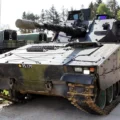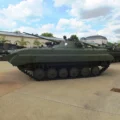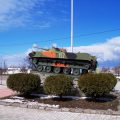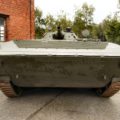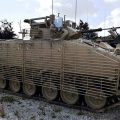
Schutzenpanzer Lang HS.30 | |
|---|---|
| País | Alemania Occidental |
| Tipo | Vehículo de combate de infantería |
| Período | Década de 1950 |
| Construido | Más de 2000 |
el Schützenpanzer Lang HS.30 (también Schützenpanzer 12-3) fue un vehículo de combate de infantería de Alemania Occidental desarrollado durante la década de 1950. Era un diseño suizo Hispano-Suiza, con un motor Rolls-Royce. Después de algunos problemas mecánicos iniciales, solo se construyeron unos 2000 de los 10,000 planeados. Estaba armado con un cañón de 20 mm que era un arma inusualmente poderosa para un vehículo blindado de transporte de personal de la época. Su diseño demostró tener muchos defectos e inconvenientes y la construcción fue seguida por un gran escándalo político en Alemania Occidental en la década de 1960. 2176 SPz 12-3 y variantes se construyeron hasta 1962, por lo que el gobierno alemán pagó 517 millones de marcos alemanes, o alrededor de 238.000 marcos alemanes por vehículo. El SPz 12-3 se implementó por primera vez en 1958 y fue reemplazado por el vehículo de combate de infantería Marder de 1971
| Schutzenpanzer Lang HS.30 Caminar | |
|---|---|
| Fotógrafo | Vladimir Yakubov |
| Localización | Museo Militar del Sur de Nueva Inglaterra |
| Fotos | 79 |
| SPz Lang HS-30 Paseo alrededor | |
|---|---|
| Fotógrafo | Unknow |
| Localización | Unknow |
| Fotos | 30 |
Ver también:
el Schutzenpanzer Lang HS.30 was a West German infantry fighting vehicle that entered service in 1960. It was designed by the Swiss company Hispano-Suiza, and had a 20 mm HS 820 autocannon as its main armament. The HS.30 was intended to provide fire support and mobility for the mechanized infantry units of the Bundeswehr, and to fight alongside tanks in both offensive and defensive operations. The HS.30 had a low profile, a torsion bar suspension, and a Rolls-Royce B81 petrol engine that gave it a top speed of 58 km/h.
However, the HS.30 also suffered from many technical problems and reliability issues, such as engine overheating, transmission failures, and poor quality control. The HS.30 was also involved in a political scandal in the 1960s, when it was revealed that the German government had paid a much higher price than originally agreed for the vehicle, and that there were irregularities and corruption in the procurement process. The HS.30 was gradually replaced by the more modern and effective Marder infantry fighting vehicle from 1971 onwards, and was phased out of service by the 1980s.
Vistas : 3208


